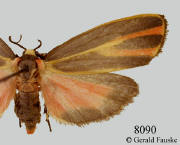|
A Key to the superfamilies of the Lepidoptera
with special reference to North and South Dakota
Superfamily
Noctuoidea
The single
synapomorphy (shared derived character) uniting this vast assemblage of moths is
the presence of a metathoracic tympanum. In diurnal species, the tympanum
is reduced to bulges and not readily recognizable but these species are marked
with red or orange on the thorax or abdomen. The tympanum can be well
hidden in the vestiture of some very hairy moths. Recent work in both
mtDNA and morphology has shown that while the traditional superfamily Noctuoidea
is a monphyletic group, the included families consist of many paraphyletic
associations. Specifically, with regards to the North American fauna, the
families Lymantriidae (Tussock moths) and Arctiidae (Tiger and Lichen moths) are
sister groups whose closest relation in turn is the subfamily Catocalinae of the
family Noctuidae. The taxonomic choices are then to 'split' the
traditional Noctuidae into many subsidiary families (to preserve the families
Lymantriidae and Arctiidae) or to 'lump' most of the Noctuoid families under an
expanded concept of the Noctuidae. Below, and only for convenience, the
traditional four 'families' of Nearctic Noctuidae are recognized.
|
Family
Notodontidae, Prominents,
include 3,000 species worldwide and 137 in North America. One of two
noctuoid families with trifid fw venation (the second occurring in the Old
World). These moths are stout, with hair-like body scales and usually
camouflage coloration. Many members of the nominate subfamily have a
scale tuft at the middle of the fw inner margin. This tuft, pointing
upward when the moth is at rest is the origin of the Family name, noto=
back, odont= tooth. Top right: Furcula cinerea (Walker)
showing trifid venation;
Bottom right: Pheosia rimosa Packard (left), Datana perspicua
Grote & Robinson (right). |



|
|
Lymantriidae, Tussock moths,
contain 2,700 species world wide and 31 species in North America. These
moths have divergent terminal setae on each ramus of their bi-pectinate
antennae, North American species lack ocelli and a proboscis.
At right: Dasychira grisefacta (Dyar)
|
 |
|
Arctiidae, Tiger moths and
Lichen moths, most have thoracic tymbols (sound producing organs) on the
met-epimeron; hw with Sc and R fused for at least 1/4 of length of discal cell. The vertex, ptagiae or abdomen is usually marked with
orange or red. There are 11,000 species world wide and 255 in North America.
Pictured at right: tymbol of Cycnia oregonensis (Stretch) (top),
venation of ventral hindwing of Pyrrharctia isabella (J.E. Smith). |


|



 |
|
Above left: top row- Hypoprepia fucosa Hübner
(left), Cycnia oregonensis (right);
bottom row- Haploa reversa (Stretch) (left), Grammia virgo
(Linnaeus) (right).
|
|
Family Noctuidae, Owlet moths, have Sc and R of the
hindwing just touching near the wing base. Abdomen virtually never orange
(none in the northern Great Plains). Most species have one or more of the
following: meso-tibiae with spine like setae, hairy eyes, dorsal tufts on up
to five abdominal segments, or frons glossy and without scales. There are
approximately 25,000 species worldwide, and about 2,350 in North America.
At right: venation of vhw of Protoschinia nuchalis (Grote). |

|





|





|
Top row, left to right: Helicoverpa zea
(Boddie), Peridroma saucia (Hübner),
Pseudeustrotia carneola (Guenée), Acronicta morula
(Grote & Robinson), and Amphipyra pyramidoides Guenée, Bottom row,
left to right: Scoliopteryx libatrix (Linnaeus), Euclidia cuspidea
(Hübner), Catocala concumbens
Walker, Anagrapha falcifera (Kirby), and Eudryas grata (Fabricius).
|
Return to preceding
page
Return to beginning of
Key
Return to Key introduction
|
